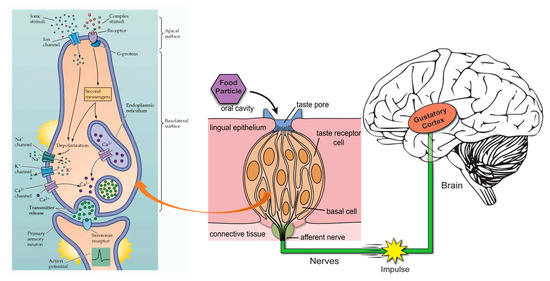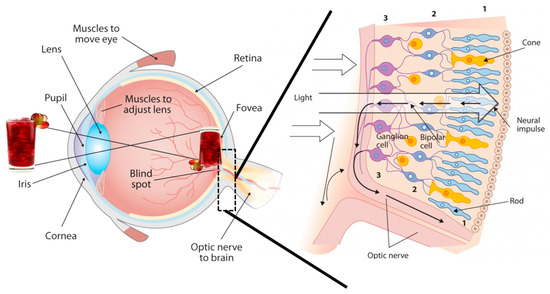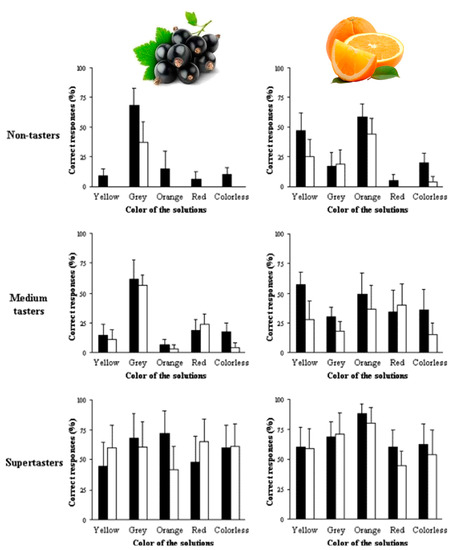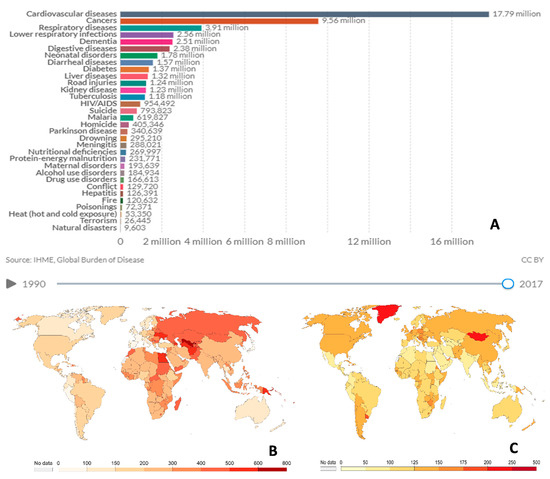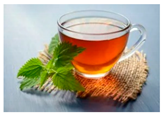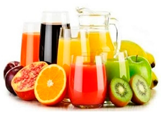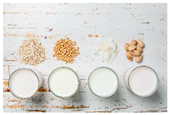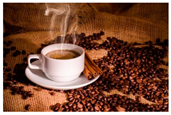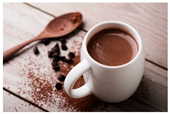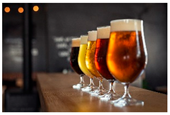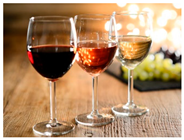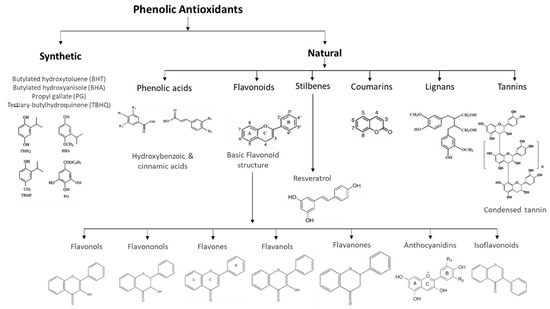Consumers increasingly prefer and seek food and beverages, which, due to their natural characteristics, bring health benefits, both in the prevention of diseases and in their curative power. In this way, the production of nutraceutical foods and beverages gains more and more importance in the market. On the other hand, and because the eyes also eat, producing attractive foods due to their color, texture, appearance, and sensory characteristics is a permanent challenge in the food industry. Being able to gather healthy and attractive items in a single food is an even greater challenge. The long list of benefits associated with phenolic compounds, such as antioxidant, anticancer, anti-inflammatory, and antiaging properties, among others, fully justifies their use in the enrichment of various food products.
1. Introduction
As many researchers state, color is an important product-intrinsic sensory cue when it comes to establishing people’s anticipations regarding the likely taste and flavor of a food or a drink. Several researchers now suggest that our experience of taste and flavor is determined by the expectations that we generate before tasting, especially when we can inspect a drink visually before deciding on whether, or not, to buy or taste it [
1,
2]. Brain and visual system development are intimately linked to the acquisition of food and drink, and contemporary neuroscience demonstrates that the sight of appealing food or drink is a powerful cue for the brain, especially the brain of a hungry person [
3].
Consequently, many of us often have our sense of taste tricked by the sense of sight. We expect the food and drink to taste like what we see. When the color of a drink is different from what was expected, our brain tells us that it will taste different. Scientific studies proved that we frequently judge food quality based on colors to identify the taste, which ultimately affects our purchase decision. Taste buds play a significant role in determining the six basic tastes—sweet, salty, sour, bitter, umami, and fat [
4]. Signals will be sent from taste buds to the brain that will interpret taste and flavor. The taste transduction mechanism is schematized in Figure 1. The apical surface of the taste receptor cell contains channels and G protein-coupled receptors that are activated by chemical stimuli. The basolateral surface contains voltage-gated Na
+, K
+, and Ca
2+ channels, as well as all the mechanisms for synaptic transmission mediated by serotonin. The ion Ca
2+ acts as a 2nd messenger and the increase in cytoplasmatic Ca
2+ occurs due to the activation of voltage-gated Ca
2+ channels or due to their release from intracellular stores. This second messenger causes synaptic vesicles to fuse and release their transmitter onto receptors on primary sensory neurons, directly to the gustatory cortex, in the brain [
5,
6].
Figure 1. Transduction mechanisms in a generic taste cell. Adapted from Purves et al. [
5] and Vera and Wooding [
6].
However, before we eat or drink, we will look at the food or drink first, and signals are sent to the brain which interprets the taste of the food or beverage before we consume it, predetermining the expected taste and flavor. The detection of shape and color is done by the eyes. Light enters the eye through the cornea, passing through the pupil at the center of the iris (Figure 2). The lens adjusts to focus the light on the retina, where it appears upside down and backward. Receptor cells on the retina send information via the optic nerve to the visual cortex. When light falls on the retina, it creates a photochemical reaction in the rods and cones at the back of the retina. The reactions then continue to the bipolar cells, the ganglion cells, and eventually to the optic nerve [
7], which sends the information to the brain (Figure 2).
Figure 2. Anatomy of the human eye and the retina with its specialized cells. (1) Light entering the eye triggers the photochemical reaction in rods and cones of the retina; (2) chemical reaction activates bipolar cells; (3) information is sent to the visual cortex via the thalamus. Retrieved and adapted from Stangor and Walinga [
8].
Moir [
9] was the first to report that people’s perception of taste and flavor could change merely by changing the color of food. Later, many researchers studied this issue, trying to comprehend how vision influences taste and flavor. Some of the researchers found that changing the hue and/or intensity of the color added to a beverage could influence the perceived identity and/or intensity of the flavor. Many people will say that a cherry-flavored drink tastes like lime if colored green, while perceiving it to taste like orange if colored orange [
10,
11]. Zampini et al. [
11] found that supertasters were significantly less influenced by the inappropriate coloring of a beverage than were medium tasters. Medium tasters were, also, less influenced than the non-tasters (Figure 3).
Figure 3. Mean percentage of correct flavor identification responses in blackcurrant and orange solutions, for the three groups of participants (non-tasters, medium tasters, and supertasters). Black columns are solutions where fruit acids had been added; white columns are solutions without fruit acids. Adapted from Zampini et al. [
11].
Thus, humans tend to associate colors with food and connect these colors to certain tastes and flavors. For example, black-colored food is usually perceived as bitter or having a burnt flavor. Bright colors, like yellow, are perceived as sweet or sour; red can be perceived as spicy. Several studies, conducted over the last thirty-five years, show that the majority of us do indeed match basic tastes to colors in a nonrandom way that is regular across individuals and consistent over time [
12,
13,
14,
15].
The phenolic compounds, which naturally occur in many fruit-based beverages, may positively or negatively affect their sensory traits, with important impacts on color, perceived taste and flavor, and astringency. Polyphenols originate from plants due to their secondary metabolism and accumulate in plant organs like leaves, fruits, roots, and stems. They are essential to plant life as they provide defense against harmful microorganisms and make plants unpalatable to predators [
16,
17]. They also present different color palettes, that may influence, as has been mentioned before, our taste and flavor perception (Figure 4).
Figure 4. Different polyphenol colors and correspondent fruits and vegetables (F&V—fruits and vegetables; AKA—also known as). Retrieved from Emerson Ecologics [
18].
Adequate consumption of phenolic compounds may offer health benefits [
19]. The consumption of fruit-based beverages, fermented or not, and rich in phenolic compounds and presenting a lovely color, has also been related to healthy diets, such as the Mediterranean diet, and to the prevention of chronic diseases since they present antioxidant properties [
19]. After the consumption of a fruit beverage rich in phenolic compounds, only a select number of phenolic compounds is absorbed into the circulatory system via the small intestine [
20]. The absorptive process is dependent on molecular complexity, size, charge, food matrix, and the presence of other drugs [
21]. A huge amount of the ingested phenolics is metabolized by the gut microbiota, generating small molecules (phenolic acids or lactone structures) that may be absorbed and exercise physiological effects [
22,
23,
24]. Evidence suggests that these metabolites have health benefits for humans [
25]. Phenolic compounds act as reducing or metal-chelating agents, hydrogen donors, and singlet oxygen quenchers [
26]. Moreover, phenolic compounds can prevent disease through mechanisms that differ from the antioxidant function, such as cellular signaling, gene expression, and modulation of enzymatic activity [
27]. Furthermore, the consumption of diets rich in phenolic compounds may also modulate human gut microbiota [
28].
However, which beverages can be considered beneficial to health by consumers? Do they associate the colors of food and beverages with the presence of beneficial compounds? Most of the research on the psychological influence of color on judgments of taste/flavor intensity has been conducted with beverages because it is easier to manipulate the level of color in solutions than in solid foods [
28] and there is a motivation to produce red fruit beverages like grape juice or grape nectar for their important nutritional properties [
29,
30]. Red coloring in beverages and foods also appears to be a particularly good inducer of sweetness. It seems that humans may have internalized the environmental association between sweetness and redness in ripe fruits [
31].
2. Classification of Phenolic Antioxidants
Phenolic compounds are classified as primary antioxidants [
53] and originate from one of the main classes of secondary metabolites in plants. They have antioxidant properties through several mechanisms: (i) the ability to remove free radicals and inhibit the formation of reactive species during the normal course of metabolism; (ii) preventing the occurrence of damage to lipids, proteins, and nucleic acids; and (iii) preventing consequent cell damage and death [
56]. Thus, they are commonly associated with preventing the development of cardiovascular diseases, neurodegenerative diseases, autoimmune diseases, diabetes, and cancer [
57,
58,
59,
60,
61,
62].
Depending on their origin, phenolic antioxidants can be classified as natural or artificial. Figure 5 shows the classification of phenolic antioxidants.
Figure 5. Phenolic antioxidants classification. Adapted from Shahidi and Ambigaipalan [
53].
Antioxidants used in foods and beverages are intended to prevent their deterioration and to increase shelf life. However, the appearance and characteristics of each food or drink, such as color and sensory proprieties, must be kept unchanged [
63]. Furthermore, they must be easy to apply and economical. The safety of food additives is verified through the application of standard methodologies by regulatory authorities, namely, the European Food Safety Authority (EFSA) or the United States Food and Drug Administration (FDA), which validate the use of substances and in which concentrations [
64].
2.1. Natural Phenolic Antioxidants in Beverages
Natural antioxidants can be obtained from plants (fruits, legumes, and vegetables), mushrooms, and algae, and are classified as phenolic compounds, vitamins, and carotenoids [
65,
66,
67].
In recent years, there has been a growing preference for natural phenolic antioxidants over artificial ones, fundamentally due to the increasing demand by consumers for functional foods and beverages with the addition of natural additives, which maintain their nutritional properties and flavor [
68]. Besides, this trend results, according to the same authors, from the preference currently given to natural phenolic antioxidants in food stabilization, and the restrictions applied by the responsible entities on the use of synthetic phenolic antioxidants [
69,
70].
Natural phenolic antioxidants have a great diversity of structures, in which the basic monomer of polyphenols is the phenolic ring [
71]. They are divided into several classes, the most representative of which are flavonoids and phenolic acids. For their part, flavonoids are further divided into flavones, flavanones, flavonols, flavanols, isoflavones, and phenolic acids and are generally classified into hydroxybenzoic and hydroxycinnamic acids [
72].
Stilbenes are a group of phenolic compounds that share a similar chemical structure to flavonoids (Figure 5). Trans-resveratrol is one of the most recognized stilbenes, present mostly in glycosylated forms. Red wine, as well as the red grapes that originate this fermented drink, are rich in resveratrol. Several studies show that moderate consumption of red wine leads to a reduction in the development of cardiovascular diseases and atherosclerotic plaques, and provides neuroprotective, antidiabetic, anti-inflammatory, antioxidant, anticarcinogenic, and antiviral activity [
73,
74,
75].
When analyzing different types of wines, namely, whites, rosés, and reds, Paixão et al. [
76] showed that red wine had significantly higher phenolic levels than the rosé and white wines, and consequently exhibited the highest antioxidant power. According to Fiori et al. [
77], the highest concentration of resveratrol is higher in red wine than in white wine because it is present in the skin and seeds of grapes. Thus, the different phenolic composition of wines is related to the grape variety, as well as the edaphoclimatic conditions of the region where the grapes are produced, cultural practices, the stage of ripeness [
78,
79], maceration [
80,
81], yeasts used in the vinification process [
82], and other winemaking conditions [
83].
Cordova and Sumpio [
84] also concluded that red wine has more health-promoting activity than beer or spirits due to its richer content of phenolic compounds, hence the increased interest in the nutraceutical value of wines.
Additionally, herbal teas and infusions are rich in natural antioxidants, mainly flavonoids: theaflavins, bis-flavanols, and fulvic acids. Their consumption has increased because they are recognized as having anticariogenic properties and antimicrobial and anticancer activity [
85,
86]. McCarthy et al. [
87] studied the antioxidant potential of plant extracts and compared them with synthetic antioxidants and vitamin E, incorporating them in pork. The catechins present in tea were shown to be more effective in terms of their antioxidant power, compared to butylated hydroxyanisole (BHA) and butylated hydroxytoluene (BHT), and antioxidant activity was evaluated through the thiobarbituric acid reactive substance assay (TBARS assay—reactive species of thiobarbituric acid).
The market for natural antioxidants is growing and new products have appeared on the market with a healthy image, namely, smoothies, functional drinks, and yogurts with green tea, grape seed, lemon balm, and aloe vera, among others [
68].
It is important to note that there are natural antioxidants that have lower antioxidant activity than their synthetic equivalents, which can lead to the use of a higher dosage, causing toxicity reactions [
88]. Thus, the intensification of toxicity studies of these compounds is necessary to know the limits of their use.
2.2. Synthetic Phenolic Antioxidants in Beverages
Several synthetic phenolic antioxidants (SPAs) are widely used in industrial and commercial products, but only a few can legally be added to food products [
89]. Thus, with a common molecular structure in which the phenolic rings are replaced by alkyls hindered in the ortho position [
70], butylated hydroxyanisole (BHA), butylated hydroxytoluene (BHT), propyl gallate (PG), and tertiary-butylhydroquinone (TBHQ) are commonly used as food antioxidants [
90]. However, BHA and BHT are the antioxidants most used as additives in food products [
91,
92].
The poor stability of natural antioxidants has increased the number of SPAs that are preferred for use in food and beverages to prevent and delay lipid oxidation reactions, preventing the formation of foreign flavors and undesirable chemical compounds, such as aldehydes, ketones, and organic acids, and prolong the shelf life of products [
93].
SPAs can be used alone or in combination. Thus, BHA is commonly found in dry cereals, derived from potatoes, in cooked foods (boiled or fried and desserts), and in drinks [
90,
94]. In food supplements, condiments, spices, chewing gum, and oils, BHT can be used alone or in combination with BHA or TBHQ [
95]. As a preservative, TBHQ is used in edible animal fats, meat products, and unsaturated vegetable oils [
96]. Propyl gallate has been used in the food industry as a stabilizer in fatty foods and as an additive in mayonnaise, fats, edible fats, and baked goods [
97].
The presence of a wide range of undesirable compounds in foods and beverages has made the area of food safety increasingly relevant, to provide the population with the necessary high-quality food. Therefore, the growing concern about using safe and environmentally friendly food products has recently led to the realization of several studies to find out if the use of SPAs in food and beverages is safe for health. Their conclusions are contradictory. In some studies, SPAs revealed antimutagenic and antitumor properties [
98,
99,
100,
101,
102] but, in others, allergic reactions, including asthma and hives [
103], toxic effects in some animal tissues [
104], liver toxicity, endocrine-disrupting effects, and even carcinogenicity [
93,
105,
106,
107] were reported, questioning their use [
70,
108].
This issue generated concern on the part of the governments of the European Union and most countries to create legislation that regulates the use of SPAs, either individually or in mixtures, as the market for combined natural or synthetic phenolic antioxidants is expected to have a growth rate of around 5% by 2023 [
109]. In the European Union, the use of certain SPAs has been restricted and has even been banned in soft drinks [
89].
3. Phenolic Antioxidants and Human Health
Although, in the present day, the main world health concern is COVID-19, the global pandemic caused by the SARS-COV-2 virus, other diseases also kill millions of people every year. Globally, the number of deaths due to cardiovascular diseases (CVDs) between 1990 and 2017 increased from 12.3 to 17.79 million (Figure 6A) [
110]. The World Health Organization (WHO) estimates that 60% of all CVDs occur now in developing nations (Figure 6B) [
110], where a recent increase in the incidence of CVDs has been driven by higher obesity rates. The global economic burden of these diseases is projected to rise from an estimated USD 863 billion in 2010 to an estimated USD 1044 billion by 2030 [
111]. This increase is expected to be most acutely felt in nations such as India, Egypt, and the republics of the former Soviet Union (Figure 6C) [
110].
Figure 6. The number of deaths by cause from 1990 to 2017 (
A); Death rate from cardiovascular disease (
B). The death rate from cancer (
C). Annual number of deaths per 100,000 people (data from 2017). To allow comparisons between countries and over time, this metric is age standardized. Data retrieved from Our World in Data [
110] and World Heart Federation [
111].
Longevity is considered by the United Nations as one of the biggest achievements of this century, and a major social transformation [
112]. Evidence supports that diets rich in plant-based foods can be associated with a lessened risk of cardiovascular disease (CVD) [
113], thus promoting longevity. The current nutritional guidelines for the prevention of CVDs include a diet high in fruits, vegetables, whole grains, nuts, legumes, and non-tropical vegetable oils, and are based on the Mediterranean diet, which is rich in phenolic compounds [
114]. Various phenolic compounds may exercise beneficial effects by reducing risk factors for the onset of CVDs and age-related disease (ARD) that involves the so-called “inflamm-aging” process [
115,
116]. The association of phenolic compounds with the reduced incidence of CVDs was studied by Lutz et al. [
117] who state that these compounds can promote a healthy aging process, retarding or even inhibiting the risk factors involved in CVDs, mainly high cholesterol levels, high blood pressure, diabetes, urinary isoprostanes, low-density lipoprotein (LDL) oxidation, platelet aggregation, and inflammatory status, among others [
118,
119,
120,
121]. All these health-related issues contribute to atherothrombosis and the consequent occurrence of CVDs [
122]. Table 1 summarizes some of the main beverages that possess polyphenolic compounds, their structures, and bioactivities.
Table 1. Alcoholic and nonalcoholic beverages, their main phenolic compounds present and indicated bioactivities.
Cancer is also a worldwide menace; it is the second leading cause of death in developed countries (A) and is increasing in developing countries. Humanity has been trying to find better and cheaper treatments with fewer side effects, to reduce the incidence of the disease and its consequent mortality [
140].
Phenolic compounds have been described as exhibiting anticancer activity in vitro and in vivo [
53,
141,
142,
143,
144] (Table 1). Their efficacy varies from one compound to another, which is due to the variations in their structures as well as their molecular targets [
145]. Structure vs. activity relationship studies have identified the involvement of aromatic rings and hydroxylic groups in antitumor activity [
146,
147]. Additionally, reports suggest that molecules with a larger number of hydroxylic groups displayed better anticancer activity compared to others with no hydroxylic groups or compounds with –OCH3 fractions [
145]. In addition, studies comparing the efficacy of cinnamic and benzoic acids in inhibiting cancer cell growth showed that cinnamic acids that contain an unsaturated propionic acid side chain are superior anticancer agents [
146,
147]. Therefore, benzoic and cinnamic acid derivatives possessing hydroxyl substitutions could be used naturally or in pharmaceutical formulas to prevent cancer cell proliferation [
145].
The mechanisms of action for the antitumor activity of phenolic compounds include stopping the proliferation of cancer cells [
148]; inducing tumor cellular apoptosis [
53,
86,
123,
124,
149] (); and preventing tumor cell migration and invasion—so-called metastasis [
53,
129,
130,
131,
150].
Another concern, in terms of wellbeing, especially in the 21st century, as life expectancy, according to the WHO, is projected to reach 73 years by 2025 [
151], is neurodegenerative diseases such as Alzheimer’s and Parkinson’s. Many thousands of people born at the end of the 20th century will live through the 21st century and see the advent of the 22nd century. People will live longer, but will they really have “quality of life”? Evidence supports that oxidative stress is involved in the pathophysiology of neurodegenerative diseases. Oxidative stress can induce neuronal damages and modulate intracellular signaling, ultimately leading to neuronal death by apoptosis or necrosis [
152].
The pathogenesis of diseases such as Alzheimer’s or Parkinson’s is multifactorial, with a complex combination of genetic and nongenetic components [
53,
125,
152]. Most of these cases are nongenetic or sporadic. According to the World Health Report [
152], inflammation, glutamatergic toxicity, dysfunction of mitochondrial activity and the ubiquitin/proteasome system, activation of apoptosis pathways, elevation of iron and nitric oxide, and alteration of the homeostasis of antioxidants/oxidation are the main mechanisms involved in neurodegenerative pathologies. Green tea, which is particularly rich in flavonoids [
86], including catechins and their derivatives, could have a beneficial role in reducing the risk of Parkinson’s disease [
53,
153]. The catechol-like structure of catechins competitively inhibits uptake by the presynaptic or vesicular transporters of the metabolite product of 1-methyl-4-phenylpyridinium ions (MPP+), also presenting a catechol-like structure. This competition protects dopaminergic neurons against MPTP/MPP+-induced injury [
154].
Alzheimer’s disease pathology progresses gradually via anatomically connected brain regions. The progressive pathology is due to the direct transfer of amyloid-β1-42 oligomers (oAβ) between connected neurons [
155]. Concerning Alzheimer’s disease, there are several in vitro studies demonstrating that green tea extract may protect neurons from amyloid β-induced damage [
156,
157].
Oxidative stress or inflammation can also be the cause of chronic diseases such as diabetes, insulin resistance, urinary tract infections, chronic obstructive pulmonary disease, and rheumatoid arthritis [
53,
158,
159]. These chronic diseases, like arthritis (also considered an autoimmune disease with unknown etiology), may accelerate cardiovascular complications [
147].
Phenolic compounds have been described as able to promote a decrease in hyperglycemia, improve acute insulin secretion and insulin sensitivity [
160], prevent rheumatoid arthritis [
161], and have antiadhesive activity against uropathogenic bacteria, preventing urinary tract infections [
162].
So, all the health menaces described above have a huge impact, not only on personal health, but also in terms of people’s productivity, wellbeing, and, ultimately, quality of life and happiness.
This entry is adapted from the peer-reviewed paper 10.3390/beverages7010012
